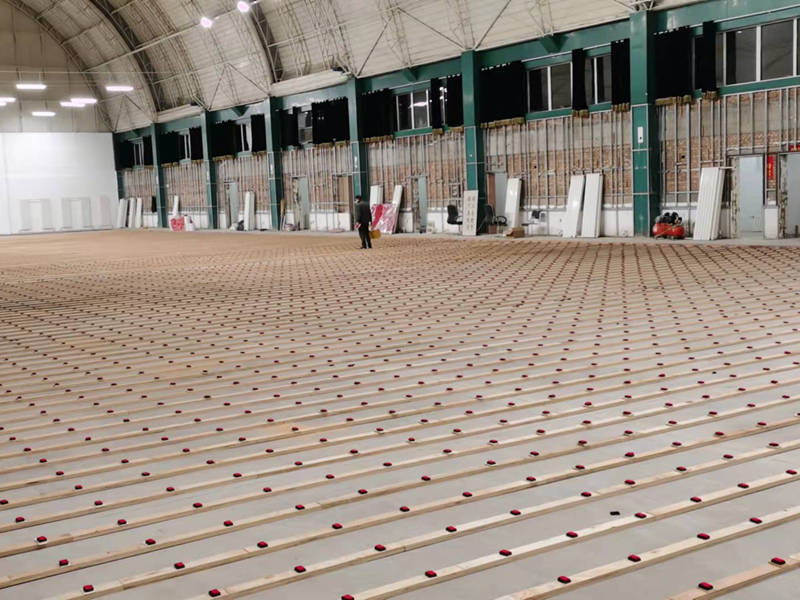
2025-07-23 13:54 Clicks:35
Here’s a detailed overview of solid hardwood sports flooring, exploring performance, benefits, drawbacks, and comparisons with engineered alternatives:
Solid hardwood sports flooring is crafted from a single piece of timber—typically hard maple—and serves as the premium standard for indoor sports surfaces. It offers authenticity, durability, and multiple refinishing options.

Solid wood can warp with humidity swings unless climate‑controlled with precision.
Maintain 45–55 % humidity and 55–75 °F temperature. Use moisture‑barrier underlayments and HVAC monitoring.
Connor Sports installs hard maple courts—crafted from Wisconsin and Michigan wood—for the NCAA Final Four. These courts last decades and are part of basketball heritage.
Longevity: Can be refinished multiple times over 40‑50+ years.
Performance: Meets MFMA rebound (≥93 %) and offers ideal shock absorption.
Aesthetic Value: Clean grain and high-grade maple improve visuals and resale value.
Eco‑friendly: Renewable, recyclable, low VOC, and certified sources available.
Installed cost can range $15–25/ft², higher than synthetic or engineered.
Despite higher startup cost (≈20% more than PVC), lifecycle savings are substantial—solid wood lasts ~38 years vs PVC’s ~15.
| Feature | Solid Hardwood | Engineered Hardwood |
|---|---|---|
| Construction | Single wood plank | Veneer over plywood or fiberboard |
| Durability & Lifespan | Can last 40–50 + years, many refinishes | 20–30 years, limited refinishing |
| Stability (moisture/temp) | Sensitive – needs strict control | More stable across humidity levels |
| Cost per ft² (installed) | $15–25 | $10–20 depending on veneer thickness |
| Repair/refinish potential | Multiple sanding/finishing cycles | Usually only 1‑2 times |
Step 1: Assess climate control—maintain 45–55 % humidity and proper HVAC.
Step 2: Use quality first‑ or second‑grade maple for professional appearance.
Step 3: Install sub‑floor with moisture barrier and appropriate shock pads.
Step 4: Lay solid maple planks per manufacturer spec; allow acclimation.
Step 5: Finish with water‑ or oil‑based low‑VOC coatings.
Step 6: Maintain daily with dry mopping; wet mop weekly with approved cleaner.
Step 7: Screen & recoat yearly; full sanding & refinishing every 7–10 years.
Step 8: Inspect bounce response and safety before use.
Solid hardwood is maintenance-free? No—daily care and climate control are crucial.
Engineered wood offers more refinishing than solid? Actually, solid often allows more cycles; engineered is limited.
Solid hardwood is suitable below‑grade? No—engineered is better in moisture-prone areas.
I led a school gym flooring install in 2024. We chose solid maple to meet performance and durability goals. However, the climate system needed tweaks to stabilize humidity. Interestingly, even small moisture shifts caused plank gaps. Nevertheless, the court performs and looks excellent after two years—proof that solid hardwood, though sensitive, delivers when done right.
Solid hardwood sports flooring remains the gold standard. It offers long-lasting performance, excellent playability, and heritage value—despite its higher upfront cost. With proper installation and maintenance, it outperforms engineered options over decades. Therefore, it’s worth the investment for demanding athletic facilities.
Confirm high-grade maple (first or second‑grade)
Ensure HVAC to maintain 45–55 % humidity, 55–75 °F
Install moisture barrier and shock absorption subfloor
Acclimate wood before installation
Apply low-VOC finish; water‑based preferred in many regions
Daily dust‑mop; weekly damp‑mop with approved cleaner
Screen & recoat annually; strip do full refinish every 7–10 years
Inspect ball rebound and surface friction periodically
Monitor for gaps or cupping; adjust climate controls as needed
Q1: How long can solid hardwood sports flooring last?
A1: With good care and periodic refinishing, solid hardwood can last 40–50+ years—much longer than PVC or engineered alternatives.
Q2: Is solid hardwood sensitive to moisture?
A2: Yes, it requires tight humidity control (45–55 %) to prevent warping and seasonal gapping.
Q3: How often should the floor be refinished?
A3: Screen and recoat yearly; full sand and refinish every 7–10 years for optimal performance.
Q4: Is engineered hardwood a better choice for unstable environments?
A4: Yes. Engineered flooring is more dimensionally stable and tolerates humidity shifts better than solidwood.
Q5: Does solid hardwood offer better bounce and shock absorption?
A5: Absolutely. Solid maple systems meet MFMA standards and deliver optimal ball rebound (~93 %) and player safety.
In sum, solid hardwood sports flooring excels in longevity, performance, and player experience. Its drawbacks—cost and sensitivity—are outweighed by its unmatched benefits when installed correctly.